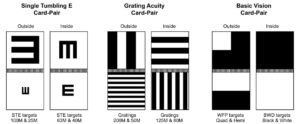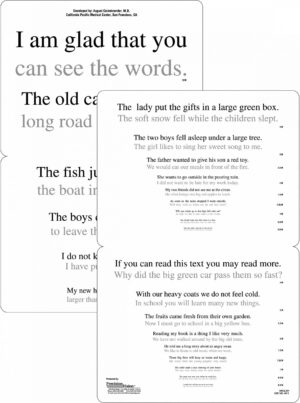Ohio State University Newborn Acuity Charts
The Newborn Acuity Cards is a card-based test of visual acuity designed for use on infants under 6 weeks of corrected age (or under 46 weeks of gestational age). The test consists of 10 gray cards, each containing a visual acuity grating, plus a blank card. The patient fixates or tracks the grating if it is visible, and the examiner makes an integrated judgment of whether the patient sees the grating or not. The test takes about 12 minutes on an awake, generally healthy infant.
$1,345.00
Description
Until now, there has not been any way to test the vision of a newborn infant. The Newborn Acuity Cards are designed to fill this gap.
The Newborn Acuity Cards exploit the innate tendency for newborn infants to look at things they can see. The examiner places each card along the infant’s line of sight while observing the infant’s looking behavior through a peephole in the center of the card. Then the examiner moves the card and observes whether the infant continues to fixate the grating and track it as it moves. The examiner uses the infant’s behavior to judge whether or not the infant saw each card, and the visual acuity is the value of the finest stripes the infant can see. Card tests based on ordinary preferential looking do not work well with newborn infants because they do not actively scan their visual environments for interesting things to look at.
The gratings on the Newborn Acuity cards are 24 cm square, and range from 0.125 cy/cm to 3.0 cy/cm. At a test distance of 57 cm, the cards range from 20/4800 Snellen (2.38 logMar) to 20/200 Snellen (1.0 logMAR) in steps of 0.15 logMAR (full set) or 0.3 logMAR (half set). The normal newborn infant’s visual acuity is 20/600 (1.5 logMAR) (Brown et al 2018), and it matures by a factor of 2 between gestational ages 32 and 42 weeks (Brown & Yamamoto 1986). The light required is the same as for any other visual acuity test. The average test time of a normal newborn infant in the postpartum unit is 12 minutes (SD: 5 min).
The Newborn Acuity Cards are laminated and can be sanitized using hospital surface wipes. They can be used in any clinical setting where newborn infants are examined, including the neonatal intensive care unit, the postpartum service, and the waiting room of an outpatient clinic.
Instructions May be Downloaded Here
© 2021 The Ohio State University








